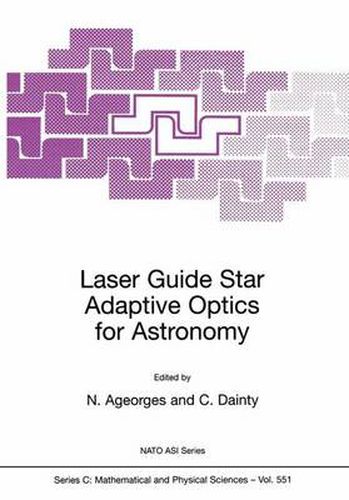Readings Newsletter
Become a Readings Member to make your shopping experience even easier.
Sign in or sign up for free!
You’re not far away from qualifying for FREE standard shipping within Australia
You’ve qualified for FREE standard shipping within Australia
The cart is loading…






This title is printed to order. This book may have been self-published. If so, we cannot guarantee the quality of the content. In the main most books will have gone through the editing process however some may not. We therefore suggest that you be aware of this before ordering this book. If in doubt check either the author or publisher’s details as we are unable to accept any returns unless they are faulty. Please contact us if you have any questions.
Adaptive optics allows the theoretical limit of angular resolution to be achieved from a large telescope, despite the presence of turbulence. Thus an eight meter class telescope, such as one of the four in the Very Large Telescope operated by ESO in Chile, will in future be routinely capable of an angular resolution of almost 0.01 arcsec, compared tot he present resolution of about 0.5 arcsec for conventional imaging in good condition.
All the world’s major telescopes either have adaptive optics or are in the process of building AO systems. It turns out that a reasonable fraction of the sky can be observed using adaptive optics, with moderately good imaging quality, provided imaging in done in the near IR. To move out of the near IR, with its relatively poor angular resolution, astronomers need a laser guide star. There is a layer of Na atoms at approximately 90 km altitude that can be excited by a laser to produce such a source, or Rayleigh scattering can be employed lower in the atmosphere. But the production and use of laser guide stars is not trivial, and the key issues determining their successful implementation are discussed here, including the physics of the Na atom, the cone effect, tilt determination, sky coverage, and numerous potential astronomical applications.
$9.00 standard shipping within Australia
FREE standard shipping within Australia for orders over $100.00
Express & International shipping calculated at checkout
This title is printed to order. This book may have been self-published. If so, we cannot guarantee the quality of the content. In the main most books will have gone through the editing process however some may not. We therefore suggest that you be aware of this before ordering this book. If in doubt check either the author or publisher’s details as we are unable to accept any returns unless they are faulty. Please contact us if you have any questions.
Adaptive optics allows the theoretical limit of angular resolution to be achieved from a large telescope, despite the presence of turbulence. Thus an eight meter class telescope, such as one of the four in the Very Large Telescope operated by ESO in Chile, will in future be routinely capable of an angular resolution of almost 0.01 arcsec, compared tot he present resolution of about 0.5 arcsec for conventional imaging in good condition.
All the world’s major telescopes either have adaptive optics or are in the process of building AO systems. It turns out that a reasonable fraction of the sky can be observed using adaptive optics, with moderately good imaging quality, provided imaging in done in the near IR. To move out of the near IR, with its relatively poor angular resolution, astronomers need a laser guide star. There is a layer of Na atoms at approximately 90 km altitude that can be excited by a laser to produce such a source, or Rayleigh scattering can be employed lower in the atmosphere. But the production and use of laser guide stars is not trivial, and the key issues determining their successful implementation are discussed here, including the physics of the Na atom, the cone effect, tilt determination, sky coverage, and numerous potential astronomical applications.